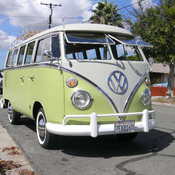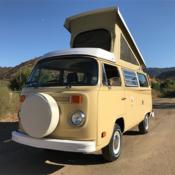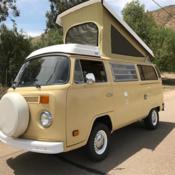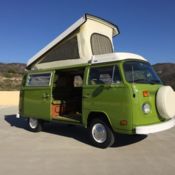Supreme 1966 - FREE Shipping @ BIN Price! Porsche 356 Powered!!!
1966 Volkswagen Beetle - Classic for sale in Houston, Texas, United States
| Condition: |
Used |
| Item location: |
Houston, Texas, United States |
| Make: |
Volkswagen |
| Model: |
Beetle - Classic |
| Type: |
Sedan |
| Trim: |
Base |
| Year: |
1966 |
| Mileage: |
47,000 |
| VIN: |
116878438 |
| Color: |
Red |
| Fuel: |
Gasoline |
| Transmission: |
Manual |
| Drive type: |
RWD |
| Interior color: |
White |
| Options: |
Sunroof |
| Vehicle Title: |
Clear |
| Want to buy? |
Contact seller!
|
Description for Volkswagen Beetle - Classic 1966
The Type 1's genesis can be traced (primarily) to the work of three brilliant automotive engineers: Joseph Ganz, ans Ledwinka and Ferdinand Porsche.Joseph Ganz was Jewish engineer with a penchant for controversy which survives him to this day. In 1923, hile studying mechanical engineering, anz had developed an automobile design that featured a mid-engine, unnel frame automobile with independent suspension. Shortly after graduating from university, anz became the editor in chief of a car magazine which was eventually named Motor Critic. As editor, r. Ganz began to openly criticize the 1920’s era automobiles then being produced by the German auto industry. His chief complaints against these “devil’s carts” revolved around their inefficient drive trains, igh centers of gravity, reat weight, ack of independent suspension and solid axles. Using his voice at Motor Critic, anz began to advocate for the development of lightweight, erodynamic, ear mounted, ndependently suspended, ube chassis automobiles. Importantly, r. Ganz not only advocated for these alternative cars but he also began to design them.In the late 1920’s Ganz began having discussion with German motorcycle manufacturer Zundapp to build a prototype of his design. During these discussions Ganz disclosed many of his ideas to Zundapp and they retained them for future use. These discussions broke down and Zundapp hired Ferdinand Porsche to build an “Auto fur Jedermann” (“Auto for Everyman”). In 1931, he first Porsche designed prototype was produced – the Zundapp 12 – and by 1932 three were in operation. This prototype is widely considered to be the first manifestation of what was to become the VW Beetle. However, ne year prior to the appearance of the Zundapp 12, r. Ganz and the Ardie motorcycle company produced an operational prototype – the Ardie-Ganz prototype - which captured, n part, anz’s vision of a proper automobile. This prototype featured a central tunnel or tube chassis which supported the car’s suspension, ngine and drivetrain, t had a mid-mounted engine and swing axle suspension at all four corners. In examining archival photographs of the Ardie-Ganz prototype, ne cannot escape the similarity it bears to a 1970’s American classic – the Volksrod. After demonstrating the Ardie prototype, r. Ganz received an offer to build a second prototype from the German car manufacturer, dler. Ganz completed this prototype in 1931 and nicknamed it the “Maikafer” or “May Bug.” After completing this car, anz took it on a promotional tour to display its technological advancement. According to one source, erdinand Porsche not only saw the May Bug but actually rode in the car.In the summer of 1931, anz was retained to consult with Mercedes Benz on the development of a prototype vehicle similar to the May Bug. Working with other engineers at Mercedes, anz produced the 120H prototype which featured modern “Beetle-esque” body panels, tube chassis and a rear mounted, ir cooled boxer engine. Mercedes never brought this car into production and Ganz was left without a manufacturer for his May Bug.After Ganz left Mercedes, e began working with another German car manufacturer Standard Fahrzeugfabrik. Using patents he had obtained over the years, anz and Standard were able to produce a production version of the May Bug called the Standard Superior. This car had a tubular chassis, horizontally opposed, 2 stroke, cylinder engine mounted in the rear of the car. However, he engine was in front of the rear, wing axle transaxle and the car had independent front suspension. This production car first appeared in February 1933, t the Berlin Auto Show (and may have been seen there by the then Chancellor Hitler). By September 1933, tandard was producing promotional literature describing the Standard Superior as “the fastest and cheapest German Volkswagen.” Within a year of the appearance of the Standard Superior, anz was placed under arrest by the Gestapo under allegations that he was attempting to blackmail a Czech company, atra. This allegation appeared to be completely baseless but, n June 1934 – shortly after Hitler ordered Porsche to develop his people’s car - Ganz fled from Germany to Switzerland where he attempted, ithout great success, o resurrect his May Bug.The company that Ganz was accused of attempting to blackmail - Tatra - employed one of Europe’s greatest automobile engineers, ans Ledwinka. In 1921, edwinka was appointed to the position of chief design engineer at Tatra and by 1923 he had designed the first known tube or “backbone” chassis. Ledwinka also invented versions of swing axle transaxles, ndependent front suspension and rear mounted, orizontally opposed, ir cooled engines. Perhaps his greatest automotive contribution was in the field of aerodynamics. Using his designs, atra brought the first streamlined automobile bodies to market and forever changed the bodies of automobiles.In the early 1930’s Ledwinka and his design partner, rich Überlacker, egan design on a rear engine, ubular chassis car named the V570 prototype. The first prototype was completed in 1931 and then went through a second design iteration. In 1933, he V570 achieved its final incarnation. This car had the following characteristics: a four seat sedan with a tubular chassis and a rear mounted two-cylinder air-cooled boxer engine which was attached to an integrated swing axle gear-box (sounds like a Beetle, uh?). Perhaps the most innovative aspects of the car revolved around the manner in which air was circulated to the rear mounted engine. Ledwinka’s ideas in this area were patented and, eemingly, rotected. Owing to the success of another Tatra model, he Tatra 57, he V570 prototype was shelved and the car was never placed into production. Ledwinka was personally acquainted with Hitler and had several dinners with him where the subject of automobiles was discussed. After one of these dinners Hitler is reported to have said to Porsche “This [a Tatra] is the car for my roads.” In 1933, fter the appearance of the Standard Superior and the design of the V570 prototype, itler ordered Ferdinand Porsche to develop a “Volkswagen” or “people’s car.” In May 1934, n Berlin’s Kaiserhof Hotel, itler gave the following design parameters to Porsche: the car must seat 2 adults and 3 children, t must be rear engine and air cooled, t must be able to travel at 62 mph and obtain fuel economy of 22 mpg. Further, orn out or broken parts must be able to be replaced easily and cheaply. After receiving these directives, orsche began meeting regularly with Ledwinka to discuss the design of the Volkswagen Beetle. In later life Porsche stated that at these meetings “… sometimes I looked over [Ledwinka’s] shoulder and sometime he looked over mine.” Building upon the work that preceded him, ncluding the Zundapp 12, he May Bug, he Standard Superior and the V570, orsche first produced the Type 60 prototype. This prototype saw several iterations and, ith help from Mercedes, as placed into limited production for testing purposes only. On May 26, 938, fter the Beetle had been approved for production, itler spoke at the Volkswagen factory and officially named the car the “Kraft durch Freude-Wagon” or “Strength through Joy Car.” Following this speech, he Beetle was intended to be placed into production (and a handful of pre-War cars were actually produced). Subsequently, atra filed suit against VW claiming that the KdF Wagon infringed on no less than 10 of its patents. This lawsuit was stopped when Germany invaded Czechoslovakia and occupied the Sudentenland in 1938. In 1961, olkswagen settled the suit by paying Tatra $3,000,000 German marks.Following the end of World War II, he Americans passed control of the Volkswagen factory over to the British who had plans to disassemble it and ship it CKD-style to Britain. However, o British car manufacturer wanted the factory or the car. In fact, ne detractor stated “... the vehicle does not meet the fundamental technical requirement or a motor car … it is quite unattractive to the average buyer.”Fortunately, British Army officer named Major Ivan Hirst, as assigned responsibility for the VW factory. Hirst convinced his superiors to order 20,000 Beetles and by 1946, he factory was producing approximately 1,000 cars per month. Under Hirst’s direction, he KdF-Wagon was renamed the Beetle and the rest, s they say, s history.The example presented here is one of the 21,529,464 Beetles built between 1938 and 2003. The luster of its red paint is truly striking. The original restorer of this car matched the paint to that placed on a 1960's era Porsche 356B. Although 20 years old, he paint is defect free and is of far better quality that what originally graced the car. The paint has no rock chips or other imperfections and, n all truthfulness, he paint looks as good today as it did in 1966 (perhaps better). More importantly, he paint is not blemished by a single sign of rust. That is, here are no rust bubbles and there is no know rust on any portion of this car.In similar fashion, he car's chrome is virtually perfect and is not pitted or cracked. It shines brightly and polishes easily. The bumpers, eadlight rings, unning board and body strips, ntenna, ront turn signal housings, ide mirrors, ront vents, nd rear fender panels are all in excellent condition, s is the rubber which surrounds them.Please note the pictures showing the mounting points of the bumpers to the body. As shown, he supporting arms for the bumpers look new and the rubber surrounding them is also exemplary.The roof rack is not original to the car and car be easily removed. It is also blemish free and brand new. I personally find it appealing and believe that it adds to the overall charm of the car. If you disagree then you may remove it without any damage to the vehicle or its paint.The chrome wheels are Porsche 10 slot rims with matching Wolfsburg nipple hubcaps and, gain, hey are virtually perfect. The rims are topped by Bridgestone Potenza 205/55R15's which appear to have virtually no miles on them. The car's spare tire is also a chrome 10 slot rim and the spare tire is completely serviceable. The spare tire compartment has no rust and is not even dirty.The car has an original jack in the proper place. Both the jack and the bracket holding it look to be in "as new" condition.The car has a complete set of original tools in a green cotton canvas back. Owing to their pristine nature, hese tools are presumed to be replicas (nice, ust free, nused ones though).The car is equipped with two window washers and reservoirs. The original reservoir was designed to tap into the spare tire and use its air pressure to power the system. Owing to its poor design, he prior owner bypassed this system and installed a modern electrical pump and large reservoir in the car. The small black button beside the ashtray activates the second system. As the car looks like it has never been driven in rain, his appears to be something of an "I have done everything else, might as well do this" item.In the boot, he rear of the car's instrument cluster and attendant wiring is covered by a black plastic cover which is far more durable than the original fiberboard.Please note the photographs which show the condition of the painted boot hinges. These hinges are emblematic of the entire car and show that its restoration was performed at the highest level possible.The interior of the car is in the same superior condition as the exterior and is impressively fitted with white vinyl seats in traditional VW basket weave. There are four three point seat belts in the car which are of new manufacture. The seat belt locks bear the Wolfsburg crest and function properly.The door cards are a matching white as is the headliner and the sun visors.The speedometer, dometer and gas gauge are fully functional and accurately record the car's vital statistics.The speedometer has been conveniently hash-marked with yellow lines to serve as a de facto tachymeter and indicate the maximum rpm's/speed for each respective gear.Please note, he car will be sold under an Arizona title which states that the mileage on the title is "ACTUAL MILEAGE"!!!Given the supremely well cared for nature of this vehicle and its fundamentally sound character, have no reason to believe that this is an inaccurate representation.While I cannot personally attest to the veracity of any mileage claims, can state that it is common to rely on mileage statements placed on auto titles.Thus, hen you go to register this vehicle you may be able to record the mileage as actual miles.Returning to the interior of the car, he steering wheel is devoid of cracks and has a bright, npitted trim ring which is capped by a Wolfsburg crest horn button.A convenient cargo tray sits directly under the dash and is useful for storing routine trip items. This tray is made of plastic and is of German manufacture but is not original to the car. However, t is age appropriate and fits into both the era and the concept of the car.The car has original design rubber front and rear floor mats with integrated tunnel covers. A pair of fitted VW logo floor mats will also be sold with the car.In order to monitor the Porsche 356 power plant, n aftermarket oil temperature gauge has been installed on the left side of the steering wheel below the dash.The sunroof opening is covered with perforated white vinyl and opens and closes with ease. The hand crank operates flawlessly and the tracks on which the sunroof slides are seemingly close to new. In order to fully close the sunroof, t is necessary to "over crank" the hand lever by about 1/4th of a turn. This can probably be adjusted but owing to my unfamiliarity with such things, have decided to live with this minor imperfection.The car will be sold with an indoor car cover which fits the car nicely and will protect it nicely from the dusty perils lurking in your garage.Placing its stately appearance aside, he most impressive aspect of this car is its Porsche 356 engine. The engine number is P609233 which, ccording to the Pelican Parts website, ndicates that the engine is from a Porsche 356 manufactured between January 1960 and September 1961. Further, he website indicates that the engine is of the 1600 variety (see www.pelicanparts.com/356/technical_specs for verification). Thus, n stock form, he engine is capable of producing approximately 60 horsepower!Documents in my possession indicate that the entire car was restored in 1989. This restoration included a complete engine rebuild (by Modern Specialists in Boulder, olorado), he installation of a super street transmission with 3:88 ratios, owder coating of all engine tins (25 pieces), eats recovered and new carpet installed. After this restoration, he car has been continuously garage kept and it appears to be in gently used condition to this day.There are numerous other maintenance records in my file, ncluding a notebook which documents the monies spent to restore and maintain the car. The most salient of these records indicate that in 2006 the car was converted to 12 volts with the following items being replaced:New battery;New voltage regulator;New wiper armature;New turn signal relay;New H4 Headlights;New dimmer relay;New Bosche blue coil;New horn;New horn ring;New antenna; andNew 4 point seat belts.If you are interested in acquiring this pristine automobile then please call Mark Counts at 713-320-3059.
 VERY NICE ORIGINAL "RUST FREE" 1967 13 WINDOW DELUXE VW BUS. FREE SHIPPING!
VERY NICE ORIGINAL "RUST FREE" 1967 13 WINDOW DELUXE VW BUS. FREE SHIPPING!
 Karmman Ghia Porsche 356 914 912 Porsche powered
Karmman Ghia Porsche 356 914 912 Porsche powered
 1966 karmann ghia Subaru Powered!!!!!
1966 karmann ghia Subaru Powered!!!!!
 VW VOLKSWAGEN WESTFALIA CAMPER VAN BUS * FREE SHIPPING W/ Buy It Now
VW VOLKSWAGEN WESTFALIA CAMPER VAN BUS * FREE SHIPPING W/ Buy It Now
 VW VOLKSWAGEN GOLF GTI OETTINGER MK1 FREE SHIPPING!!!!
VW VOLKSWAGEN GOLF GTI OETTINGER MK1 FREE SHIPPING!!!!
 1979 VW VOLKSWAGEN WESTFALIA CAMPER VAN BUS * FREE SHIPPING With Buy It Now
1979 VW VOLKSWAGEN WESTFALIA CAMPER VAN BUS * FREE SHIPPING With Buy It Now
 1978 Volkswagen VW WESTFALIA CAMPER VAN BUS *FREE SHIPPING WITH "BUY IT NOW"
1978 Volkswagen VW WESTFALIA CAMPER VAN BUS *FREE SHIPPING WITH "BUY IT NOW"
 1978 VW VOLKSWAGEN WESTFALIA CAMPER VAN BUS * FREE SHIPPING W/ "BUY IT NOW"
1978 VW VOLKSWAGEN WESTFALIA CAMPER VAN BUS * FREE SHIPPING W/ "BUY IT NOW"
 1978 VW VOLKSWAGEN WESTFALIA CAMPER VAN BUS * FREE SHIPPING W/ Buy It Now
1978 VW VOLKSWAGEN WESTFALIA CAMPER VAN BUS * FREE SHIPPING W/ Buy It Now